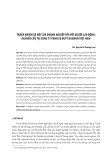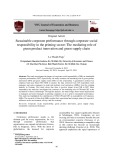
Hue University Journal of Science: Economics and Development
pISSN 2588-1205;eISSN 2615-9716
Vol. 134, No. 5S, 2025, pp. 05–30, DOI: 10.26459/hueunijed.v134i5S.7694
HOW DOES CORPORATE SOCIAL RESPONSIBILITY
INFLUENCE COMPETITIVENESS OF LUXURY HOTELS?
THE MEDIATING ROLE OF ENVIRONMENTAL
PERFORMANCE
Huynh Cat Duyen1, 2 *, Hoang Trong Hung3, Tran Thi Ngoc Lien1
1 School of Hospitality and Tourism - Hue University, 22 Lam Hoang St., Hue, Vietnam
2 Nha Trang University, 02 Nguyen Dinh Chieu St, Nha Trang, Khanh Hoa, Vietnam
3 University of Economics, Hue University, 99 Ho Dac Di St., Hue, Vietnam
* Correspondence to Huynh Cat Duyen <huynhcatduyen@hueuni.edu.vn>
(Submitted: December 5, 2024; Accepted: December 13, 2024)
Abstract. While the impact of corporate social responsibility (CSR) initiatives has been widely discussed in
the literature, the mechanism of how CSR can promote competitiveness remains largely unexplored. This
study takes a closer look at environmental performance (EP) as a mediator in the causal interaction between
CSR and competitiveness in the accommodation sector, specifically in luxury hotels (4-5 stars). This study
is considered a trend, as CSR-oriented innovation is increasingly seen not only as an answer to
environmental needs but also as a driver of sustainable growth. Data were collected from 249 managers
from various high-end resorts in Khanh Hoa, Vietnam, and Partial Least Squares Structural Equation
Modeling (PLS-SEM) was utilized to analyze the data. The findings supported all hypotheses, indicating
that the implementation of CSR activities not only ensures success in enhancing competitiveness but also
positively affects the hotel's EP. The results of this study also confirm the mediating role of EP in the
relationship between CSR and hotel competitiveness.
Keywords: corporate social responsibility, environmental performance, competitiveness, luxury hotels
1 Introduction
Building upon previous studies, the relationship between corporate social responsibility (CSR),
environmental performance (EP), and corporate competitiveness remains an area of growing
importance, especially in industries such as hospitality where environmental concerns are
particularly acute. In addition to the established links between CSR, environmental performance,
and competitiveness [1–3], it is essential to understand how these factors interplay within the
specific context of the hotel industry. Hotels often face increasing pressure to balance
environmental responsibility with profitability, making the role of CSR in driving competitive
advantage a key area for investigation. For instance, hotels that invest in environmentally
sustainable technologies and practices, such as energy-efficient systems and waste reduction

Huynh Cat Duyen et al.
Vol. 134, No. 5S, 2025
6
programs, not only enhance their environmental credentials but can also benefit from cost
savings, improved customer loyalty, and a stronger market position [4].
One possible avenue for exploration is how CSR initiatives related to EP can act as a
strategic tool to differentiate hotels in competitive markets. Studies have shown that consumers
are increasingly aware of environmental issues and prefer to patronize businesses that
demonstrate genuine concern for sustainability [5]. This growing consumer preference for eco-
friendly businesses could enhance the competitiveness of hotels that adopt robust CSR policies
aimed at improving environmental performance. Additionally, CSR-driven EP improvements
may lead to operational efficiencies and cost reductions that enhance profitability, offering a dual
benefit of environmental and economic gains [6].
While much of the existing literature has focused on developed markets [7-8], there is a
noticeable gap in research regarding the influence of CSR and EP on competitiveness in
developing economies. In countries like Vietnam, where the tourism and hospitality sectors are
rapidly growing, the implementation of sustainable practices could be crucial for long-term
competitiveness [9]. The unique challenges faced by hotels in developing countries - such as
limited access to green technologies, lower consumer awareness, and resource constraints - make
it essential to understand how CSR can be strategically implemented to improve EP and
competitiveness in these regions.
Moreover, the hotel industry itself is a major contributor to environmental degradation,
particularly in areas like energy consumption, water usage, and waste management [10]. As
environmental regulations tighten globally, hotels are under increasing pressure to implement
green strategies, not only to comply with legal requirements but also to maintain their reputation
and competitiveness in the marketplace. Hotels that integrate environmental sustainability into
their corporate strategies are likely to enjoy a competitive edge, especially as more travelers
prioritize eco-friendly accommodations [11]. Research in this area could benefit from examining
how CSR and environmental strategies are translated into specific competitive advantages for
hotels, particularly in the context of rapidly developing tourism markets where there is a growing
demand for sustainable business practices.
This study delves into the impact of CSR on the competitiveness of luxury hotels,
specifically within the Khanh Hoa region of Vietnam. Through an in-depth literature review, the
study develops a research model that identifies key indicators for measuring CSR activities.
Hypotheses are formulated to explore the relationships between CSR, EP, and competitiveness.
Furthermore, the study investigates the mediating role of EP in the CSR-competitiveness link.
While CSR is widely believed to enhance hotel competitiveness, this research aims to examine
the nuanced mechanisms through which CSR influences EP, thereby indirectly bolstering
competitiveness. The findings of this study are expected to provide valuable insights for hotel

Jos.hueuni.edu.vn
Vol. 134, No. 5S, 2025
7
decision-makers, informing the development of effective CSR strategies aligned with
environmental management. Ultimately, these insights aim to contribute to the enhancement of
hotel competitiveness and sustainable development within the region.
2 Theoretical backgrounds
2.1 Competitiveness
The concept of competitiveness has evolved significantly since its introduction in the early 1980s.
While Porter [12] initially emphasized labor productivity as a key measure, a broader
understanding has emerged. Competitiveness is now recognized as the ability of an enterprise to
create, maintain, and innovate competitive advantages, leading to higher productivity, superior
quality, increased market share, and long-term sustainability. A central tenet of Porter's work is
the importance of sustainable competitive advantage. He introduced the 5-force model to analyze
industry competition, identifying five key factors: (1) competition among existing firms; (2) threat
of new entrants; (3) threat of substitute products or services; (4) bargaining power of suppliers;
and (5) bargaining power of buyers. This model provides a framework for understanding the
competitive landscape and developing effective strategies.
Business competitiveness is defined as an organization's ability to sustain and enhance its
market position by optimizing internal resources and responding effectively to external
opportunities. This capability involves delivering exceptional value to customers, fostering
innovation, and adapting to changing economic, technological, and societal conditions. Recent
research emphasizes the critical role of innovation strategies and advanced technologies,
including artificial intelligence and business intelligence systems, in driving competitive
advantages. These technologies enhance decision-making processes, operational efficiency, and
innovation potential, making them vital for thriving in dynamic market environments [13-15].
Furthermore, environmental, social, and governance (ESG) practices are increasingly
integral to business competitiveness. Organizations aligning their strategies with sustainability
not only meet societal expectations but also improve long-term profitability and resilience. This
intersection of innovation, sustainable practices, and strategic resource allocation reflects a
comprehensive approach to maintaining competitive advantage in contemporary markets [14,
15]. The integration of these elements demonstrates that competitiveness extends beyond
financial performance, encompassing adaptive capabilities and alignment with broader societal
and technological trends.
Synthesizing concepts of enterprise competitiveness from previous studies, the author
approaches enterprise competitiveness as the ability to enhance internal operating efficiency,
consolidate and improve market position, design, produce, and sell goods/services with

Huynh Cat Duyen et al.
Vol. 134, No. 5S, 2025
8
competitive prices and quality, capture significant market share, generate high income, and
develop sustainably.
2.2 Stakeholder theory
Stakeholder theory, originally proposed by Freeman [16], argues that organizations should
consider the interests and well-being of all stakeholders, rather than prioritizing shareholder
value alone. Stakeholders include a variety of entities, including employees, customers, suppliers,
communities, governments, and the environment, all of which are affected or can affect the
organization's operations. This theory emphasizes the interdependence between organizations
and their stakeholders, emphasizing that long-term success requires fostering trust, cooperation,
and mutual benefit [16]. Furthermore, stakeholder theory incorporates ethical considerations,
advocating transparency and fairness in addressing stakeholder concerns, beyond purely
economic goals [17].
By integrating diverse perspectives, organizations can enhance innovation, reduce risk,
and align their strategies with societal expectations. However, critics argue that stakeholder
theory can dilute organizational focus by requiring managers to balance conflicting needs,
potentially complicating decision-making processes [18]. Despite these challenges, stakeholder
theory remains a foundational framework in the discourse on business ethics and sustainability,
providing a comprehensive approach to understanding the link between business performance
and social impact.
In addition, stakeholder theory plays a pivotal role in understanding the dynamic
relationship between corporate social responsibility, environmental performance, and
competitiveness. By emphasizing the links between organizations and their stakeholders, this
theory provides a framework for businesses to develop specific action strategies that align
economic goals with social and environmental responsibilities. This legitimacy is especially
important for improving environmental performance, as stakeholders increasingly demand
sustainable practices and accountability for environmental impacts [19].
Furthermore, stakeholder theory emphasizes how proactive interactions with stakeholders
can promote competitiveness. Companies that align their CSR strategies with stakeholder
interests often enjoy improved brand reputation, customer loyalty, and employee satisfaction, all
of which contribute to competitive advantage. Integrating the environmental performance
achieved when businesses implement social responsibility within this framework enables
businesses to differentiate themselves through innovation, cost savings from resource efficiency,
and compliance with regulatory standards, thereby further strengthening their market position
[20].

Jos.hueuni.edu.vn
Vol. 134, No. 5S, 2025
9
2.3 Resource-based view theory
The resource-based view (RBV), introduced by Barney [21], argues that firms achieve sustainable
competitive advantage through unique, valuable, rare, and inimitable resources. These resources
underpin strategic differentiation and long-term success. In 1995, Hart [22] proposed the natural
resource-based view (NRBV) of the firm by incorporating environmental sustainability into the
strategic framework of competitive advantage. While the RBV emphasizes the importance of
valuable, rare, inimitable, and non-substitutable (VRIN) internal resources as a source of
competitive advantage [21], the NRBV extends this idea to include a firm's ability to address
environmental challenges. According to Hart [22], the growing importance of sustainability and
environmental responsibility requires companies to develop capabilities that are consistent with
ecological constraints and stakeholder expectations.
The NRBV identifies three interconnected strategies through which firms can leverage
environmental issues for competitive advantage. The first, pollution prevention, focuses on
minimizing waste and emissions through process innovation. This approach not only reduces
environmental impact but also enhances operational efficiency, lowering costs and improving
profitability. The second strategy, product stewardship, extends the environmental focus across
the lifecycle of a product, from design to disposal. By considering the environmental implications
of their products, firms can respond to growing consumer demand for sustainable offerings and
strengthen stakeholder relationships [23]. Finally, sustainable development addresses the
broader, long-term need to reduce dependency on non-renewable resources and preserve
ecosystems. This strategy often involves innovations that contribute to global sustainability while
securing a firm's future resource needs [24].
By integrating these strategies, the NRBV suggests that firms can transform environmental
challenges into opportunities for innovation, market differentiation, and cost reduction.
However, the theory also acknowledges challenges, such as the significant upfront investment
required for implementing sustainable practices and the dependence on external factors like
regulatory support and market readiness. Despite these challenges, the NRBV remains a critical
framework for understanding how firms can align profitability with environmental
responsibility in an increasingly sustainability-conscious business environment [25].
Researchers can leverage the natural resource-based view (NRBV) theory to
comprehensively assess corporate performance by integrating the environmental, social, and
economic dimensions of corporate social responsibility (CSR). This approach emphasizes the
strategic role of sustainability in achieving competitive advantage while addressing the urgent
need for environmental management. While previous studies have used other theoretical
frameworks, such as contingency theory to explore the relationship between environmental
strategy and management performance [26] and stakeholder theory to examine the link between


























